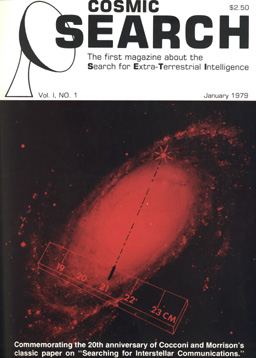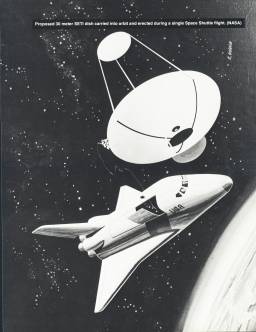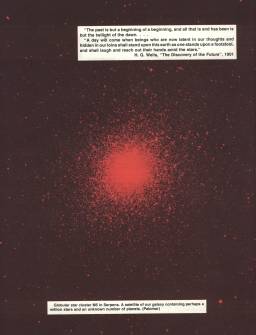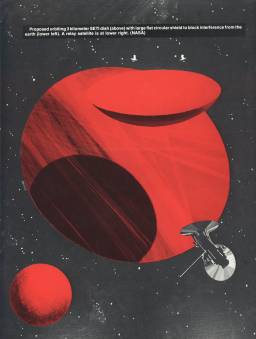Miscellaneous Items
Webpage Table of Contents (Bookmarks)
(Internal links to categories of items in this webpage)
Information About the Publication
(Editorial Board, Editors, Table of Contents)

ISSN 0161-8555
CODEN: COSEDN
Editorial Board
- Richard Berendzen, University Provost, The American University
- John Billingham, Director SETI Program, NASA-AMES Research Center
- Ronald Bracewell, Director, Radio Astronomy Observatory, Stanford University
- Thomas A. Clark, NASA-Goddard Space Flight Center
- Arthur C. Clarke, Sri Lanka, author of "2001, A Space Odyssey"
- Norman Cousins, Chairman, Editorial Board, SATURDAY REVIEW
- Frank D. Drake, Director, National Astronomy and Ionosphere Center (Arecibo), Cornell University
- Robert E. Edelson, SETI Project Manager, Jet Propulsion Laboratory, California Institute of Technology
- Donald S. Hall, Director, Strasenburgh Planetarium, Rochester, New York; President, International Planetarium Society
- Theodore M. Hesburgh, President, University of Notre Dame
- Nikolai Kardashev, Space Research Institute, Academy of Sciences, Moscow, USSR
- Philip Morrison, Physics Department, Massachusetts Institute of Technology
- Bernard Oliver, Vice President, Hewlett-Packard Company; Director of NASA-Ames Cyclops Project
- Cyril Ponnamperuma, Director, Laboratory of Chemical Evolution, University of Maryland
- Martin Rees, Director, Institute of Astronomy, Cambridge University, England
- Carl Sagan, Director, Laboratory for Planetary Studies, Cornell University
- Walter Sullivan, Science Editor, New York Times
- V. S. Troitsky, Radiophysical Scientific Research Institute, Gorky, USSR
- Sebastian von Hoerner, National Radio Astronomy Observatory
Editors, and Others Involved in the Publication
Editors: Robert S. Dixon and John Kraus, Ohio State University Radio Observatory
Managing Editor: Mirjana Gearhart, Ohio State University Radio Observatory
Subscription Manager: Lesly Arnold
Assistants: Richard Arnold, Gregory Brown, Pene Curmode, Jerry R. Ehman, Wendy McKenna, David Raub, Hazel Snyder, Janet Stevens
The Cover

The Cover: Impression of a beacon signal from a galactic source detected with a receiver tuned to a 21 CM (centimeter) wavelength.
Text at the Bottom of the Cover: Commemorating the 20th anniversary of Cocconi and Morrison's classic paper on "Searching for Interstellar Communications."
About COSMIC SEARCH
COSMIC SEARCH is published 6 times a year by Cosmic-Quest, Inc. Copyright © 1978 by Cosmic-Quest, Inc. All rights reserved.
Cosmic Quest, Inc., is a private non-profit organization dedicated to the promotion and support of SETI endeavors.
Subscription price: $12 a year in U.S. (and possessions), $16 elsewhere. Single copies: $2.50 in U.S. (and possessions), $3 elsewhere.
Address subscriptions and all other correspondence to: Radio Observatory, Box 293, Delaware, Ohio 43015.
Application to mail at second-class postage rates is pending at Delaware, Ohio, and at additional mailing offices.
Table of Contents (in magazine)
| Item | Pg |
|---|
| Editorials | 2, 3 |
| Searching for Interstellar Communication by Giuseppi Cocconi and Philip Morrison | 4 |
| Twenty Years After. . . by Philip Morrison | 7 |
| A Reminiscence of Project Ozma by Frank D. Drake | 10 |
| Little Green Men, White Dwarfs or Pulsars? by S. Jocelyn Bell Burnell | 16 |
| Trouble in Aquila by Arthur C. Clarke | 22 |
| Rendezvous with Infinity by Norman Cousins | 30 |
| Time and a Cosmic Perspective by Richard Berendzen | 36 |
| What If We Succeed? by Walter Sullivan | 37 |
| Features | |
| SETI Forum: Exclusive COSMIC SEARCH interview with Sebastian von Hoerner | 40 |
| Next Issues | 21 |
| The SEnTlnel (SETI News) | 25 |
| ABCs of SETI | 32 |
| SEARCH Awards | 39 |
| Glossary | 45 |
| Off The Shelf | 46 |
Purpose of COSMIC SEARCH
The purpose of COSMIC SEARCH is to present all aspects of the search for intelligent life in space in a popular but responsible manner.
Coming in COSMIC SEARCH
- "The Quest for Extraterrestrial Intelligence" by Carl Sagan
- "Extraterrestrial Politics" by Michael Michaud
- "Generalized Life" by Jerome Rothstein
- "Man's Role in the Galaxy" by Ronald Bracewell
- "Extraterrestrial Life: Where is Everybody?" by Jesco von Puttkamer
- "Interstellar Communication with Gravity Waves" by David Douglass
- "Cosmic Languages" by Hans Freudenthal
and many more
- FORUM: Exclusive interview on "Space Colonization and SETI" with Gerard K. O'Neill
- ABCs of SETI will explain in simple terms:
The Solar Neighborhood (the "nearby" stars)
The Galactic Neighborhood (the "nearby" galaxies)
The Second Waterhole (where is it?)
The Unique or Average Question (which are we?)
Broadband and narrowband signals (you hear them all the time)
- More SEnTlnel news reports, "Off the Shelf" books and other special features.
Glossary
- Astronomical Unit:
- A unit of length equal to the distance of the earth from the sun, about 150 million kilometers.
- Bandwidth:
- The wavelength or frequency range to which a receiver responds. Bandwidths can be described as narrow or wide, according to their range.
- Big Bang:
- The beginning event in the Universe. The explosion of this primordial fireball some 15 billion years ago caused the initial outward expansion of gas and dust which formed the universe. CETI: An acronym for Communication with Extra-Terrestrial Intelligence.
- Civilization:
- According to the Russian astrophysicist Kardashev, civilizations can be classified according to their energy outputs as follows:
- Type I:
- A civilization capable of using all of the energy falling on its planet from its "sun" for interstellar communication. (For us this would be equal to 10,000 times the present total energy consumption by mankind for all purposes.) Hence, we are more like a "Type O" civilization.
- Type II:
- A civilization capable of using the total energy output of its "sun" for interstellar communication.
- Type III:
- A civilization capable of using the total energy output of our galaxy for interstellar communication.
- Dipole:
- A configuration with a plus and minus charge. An antenna one-half wavelength long.
- Doppler Shift:
- The resulting frequency change caused by the relative motion along a line of sight between two observers.
- Exobiology:
- The study of extraterrestrial life forms.
- Fourier Analysis:
- The decomposition of a signal into its simplest harmonic curves (sines and cosines).
- Galaxy:
- A large system of stars. Our galaxy, the Milky Way, is a spiral galaxy containing some 100,000 million stars, 100,000 light years in diameter and 10,000 light years thick.
- Gigahertz:
- A unit of frequency equal to 1,000 million hertz.
- Hertz:
- A unit of frequency equal to one cycle per second.
- Hydrogen:
- The most abundant element in the universe. It radiates naturally at a wavelength of 21 centimeters.
- Light Year:
- The distance traveled by light in one year, about 10 trillion kilometers.
- Light (speed of):
- In empty space: 300,000 kilometers per second.
- Maser:
- A sensitive amplifying device employing energy jumps of atomic particles.
- Megahertz:
- A unit of frequency equal to one million hertz.
- Parametric amplifier:
- A sensitive amplifying device which employs the properties of non-linear elements.
- Redshift:
- A shift toward the longer wavelengths of the optical spectrum due to recessional velocity (the Doppler effect).
- SETI:
- An acronym for Search for Extra-Terrestrial Intelligence.
- Zeeman effect:
- A broadening or splitting of radiation from a substance into several wavelengths because of the presence of a magnetic field.
SEARCH AWARDS
For best papers on SETI
Category 1. Undergraduate students
Category 2. Graduate students
Category 3. Anyone else under 30 years of age
Papers may be on any aspect of the Search for Extra-Terrestrial Intelligence (SETI). Papers must be double-spaced typewritten with one inch margins on 8 1/2 by 11 inch bond paper and less than 2000 words in length. Any illustrations must be clearly executed.
Authors of best papers will be given a SEARCH AWARD of $100 and the paper will be published in COSMIC SEARCH. Authors should include their full address and telephone number. Authors should enclose a self-addressed stamped envelope if they wish to have their manuscripts returned. Manuscripts accepted and published are copyrighted and become the property of COSMIC SEARCH magazine.
Manuscripts may be submitted at any time. Their review is a continuous, on-going process. Each article received is reviewed by a special committee and if judged worthy, either in its original form or after revisions, will be given a SEARCH AWARD. The opinion of the committee is final.
A contestant may submit and have under review only one manuscript at a time and be eligible for only one SEARCH AWARD in one category. However, it is possible for one person to achieve SEARCH AWARDS sequentially in each of the three categories.
Address SEARCH AWARD Committee, Radio Observatory, P.O. Box 293, Delaware, Ohio 43015.
SEARCH PUZZLE
[Click on image below to obtain a larger version. In your browser you may need to uncheck the preference that says something like "Resize large images to fit in window" to avoid seeing a scaled image that appears smaller than the image below.]
Miscellaneous Quotes
The following quotes are not directly associated with any article. They are listed here in the order in which they appear in the magazine; page numbers are given. Uncredited quotes should be credited to the Editors of COSMIC SEARCH magazine.
Quote on page 6
"Observe how system into system runs;
What other planets circle other suns;
What varied beings people every star."
Alexander Pope (1688-1744)
Quotes on page 24
"Does it make sense to work at guaranteeing supplies of energy for our population in the year 2025 while ignoring the finite probability that a nuclear (war) could annihilate this same population before that date?"
Harold L. Davis, Editor of "Physics Today," endorsing statement by Victor Weisskopf that abolition of the nuclear arms race "is the first and foremost problem of our time."
"The earth is our cradle,
The solar system our kindergarten,
The galaxy our middle-school and
The universe our university."
Sedgewick Seti
"99.9 percent of the species that have ever lived on the earth are now extinct."
Richard Lewontin in "Scientific American."
"Mankind are very odd creatures."
Benjamin Franklin
Quote on page 31
"It is reasonable to believe that
- the search for extra-terrestrial intelligence will contribute significantly to the solving of our problems here on earth."
- these signals from the cosmos could contribute vastly more to our future security than instruments of mass annihilation."
- the future of the human race may depend upon keeping the rendezvous with infinity."
Miscellaneous Photos
The following photos are not directly associated with any article. They are shown on this webpage at a relatively small size in the order in which they appear in the magazine. Click on each photo to obtain a larger size version.
Photo on Inside Front Cover

Photo on Page 48

Photo on Outside Back Cover

Miscellaneous Graphics
The following graphics are not directly associated with any article. They are listed here in the order in which they appear in the magazine.
|
![[NAAPO Logo]](../../Images/NAAPOsm.jpg)
![[NAAPO Logo]](../../Images/NAAPOsm.jpg)